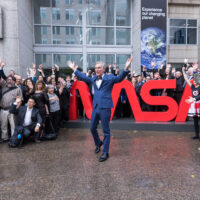Hubble, the space telescope exploring the Cosmos
The world's premiere space observatory
Highlights
- The Hubble Space Telescope, launched in 1990, is a multipurpose observatory in Earth orbit used for astrophysics and planetary science.
- Hubble has revolutionized our understanding of the Cosmos large and small. It studies asteroids and planets in our own Solar System, exoplanets and clouds of gas where stars are born, and the very fabric of the Universe itself.
- The James Webb Space Telescope is Hubble's successor.
Why do we need the Hubble Space Telescope?
A tiny patch of space that contains thousands of galaxies. A stunning peek inside a cloud of dust and gas that reveals baby star systems. Crisp views of the outer planets, year after year. Pictures like these are only possible from a telescope above our planet’s atmosphere, where the Hubble Space Telescope has been studying the Cosmos from Earth orbit for more than 30 years.
Earth’s atmosphere distorts the light from celestial objects, causing them to twinkle. Although ground-based telescopes can correct for this using a technology called adaptive optics, our atmosphere also blocks many wavelengths of light that are helpful to study the Cosmos, including infrared and ultraviolet.
Baby stars and planets often lie behind clouds of gas and dust that absorb visible light, but these objects shine through in the infrared, allowing Hubble to see them. To the naked eye, many hot, young stars blend into the glow of nearby galaxies, but Hubble can pick them out in ultraviolet light, helping scientists understand how stars and galaxies evolve.

How Hubble works
Hubble orbits Earth at an altitude of roughly 570 kilometers (350 miles). At its core, Hubble is a 13-meter-long tube (43 feet) opened to space on one end. Light travels through the tube to a bowl-shaped, 2.4-meter-wide (94.5-inch) main mirror and bounces up to a secondary mirror. That mirror concentrates the light into a beam the size of a dinner plate, which travels back through a hole in the middle of the primary mirror. From there, the light is directed through various science instruments for analysis.
What are some of Hubble's accomplishments?
Data from Hubble have revolutionized our understanding of the Cosmos. We now know the Universe is roughly 13.8 billion years old. We can make more accurate estimations of its expansion rate: 74 kilometers (46 miles) per second, per megaparsec. (For comparison, the Andromeda Galaxy lies just under 1 megaparsec away.) We think there are about 2 trillion galaxies in the Universe—that’s galaxies, not stars. When you consider that the Milky Way, a rather average galaxy, contains 100 to 400 billion stars, you start to get an idea of just how enormous the Cosmos really is.
Hubble has helped us see stars being born. It has imaged shock waves around other stars traveling through the Cosmos, and directly imaged planets orbiting other stars. Closer to home, Hubble caught comet Shoemaker-Levy 9 colliding with Jupiter in 1994. It has watched comets and asteroids break apart. Hubble’s Outer Planets Atmospheres Legacy program, OPAL, monitors the outer planets to show us how their atmospheres change over time.

International contributions
Hubble is a NASA-led project made possible through international collaboration. The European Space Agency (ESA) provided one of the telescope’s cameras and the solar arrays that give it power. A team of ESA scientists also work at the Space Telescope Science Institute (STScI) at Johns Hopkins University in Baltimore, Maryland, which operates the telescope. These contributions entitle European astronomers 15% of Hubble’s observing time.
Bias in science
In theory, anyone on Earth can use Hubble by applying for time through STScI. However, a 2014 study of Hubble time allocations found that only 18% of proposals from women were accepted, as opposed to 24% from men. NASA changed the application process so that neither proposers nor reviewers know each others’ identities or institutions. An initial test showed more equitable acceptance rates: 8.7% of women's and 8% of men's proposals were accepted.

Support missions like Hubble
Whether it's advocating, teaching, inspiring, or learning, you can do something for space, right now. Let's get to work.
Acknowledgements: This page was initially written by Jordan Strickler and is regularly updated by Planetary Society staff writers.


 Explore Worlds
Explore Worlds Find Life
Find Life Defend Earth
Defend Earth


